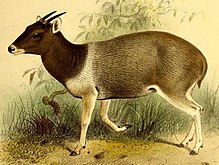Jentink's duiker
| Jentink's duiker | |
|---|---|

| |
| Scientific classification | |
| Domain: | Eukaryota |
| Kingdom: | Animalia |
| Phylum: | Chordata |
| Class: | Mammalia |
| Order: | Artiodactyla |
| Family: | Bovidae |
| Genus: | Cephalophus |
| Species: | C. jentinki
|
| Binomial name | |
| Cephalophus jentinki Thomas, 1892
| |

| |
| Distribution of Jentink's duiker | |
Jentink's duiker (Cephalophus jentinki), also known as gidi-gidi in
Jentink's duikers stand around 80 cm (31 in) tall at the shoulder and weigh about 70 kg (150 lb), making them the largest species of the duikers. They are gray from the shoulders back and dark black from the shoulders forward.[3] A white band goes over the shoulders, between the two colours and joining the white undersides. Jentink's duikers have long, thin horns, which curl back a little at the ends, and reach between 14 and 21 cm (5.5 and 8.3 in).
Jentink's duikers live mainly in very thick
The species was first recognized as a new species in 1884, though it was not described until 1892.[3] The species then vanished until a skull was found in Liberia in 1948. Sightings have occurred in its habitat since the 1960s. In 1971, the species was successfully bred in the Gladys Porter Zoo.[3]
Recent population numbers are not available. In 1999 it was estimated that around 3,500 Jentink's duikers remained in the wild, but the following year others suggested less than 2,000 were likely to remain.[1] They are threatened primarily by habitat destruction and commercial bushmeat hunters.[3]
Taxonomy
| ||||||||||||||||||||||||||||||
| Phylogenetic relationships of Jentink's duiker (Johnston et.al. 2012) |
It is classified under the genus
A 2001
References
- ^ . Retrieved 13 November 2021.
- ^ "Appendices | CITES". cites.org. Retrieved 2022-01-14.
- ^ ISBN 0-06-055804-0.
- OCLC 62265494.
- ^ "Cephalophus". Merriam-Webster.com Dictionary. Retrieved 3 March 2016.
- ^ "Duiker". Merriam-Webster.com Dictionary. Retrieved 17 February 2016.
- PMID 11527467.
- PMID 22823504.

